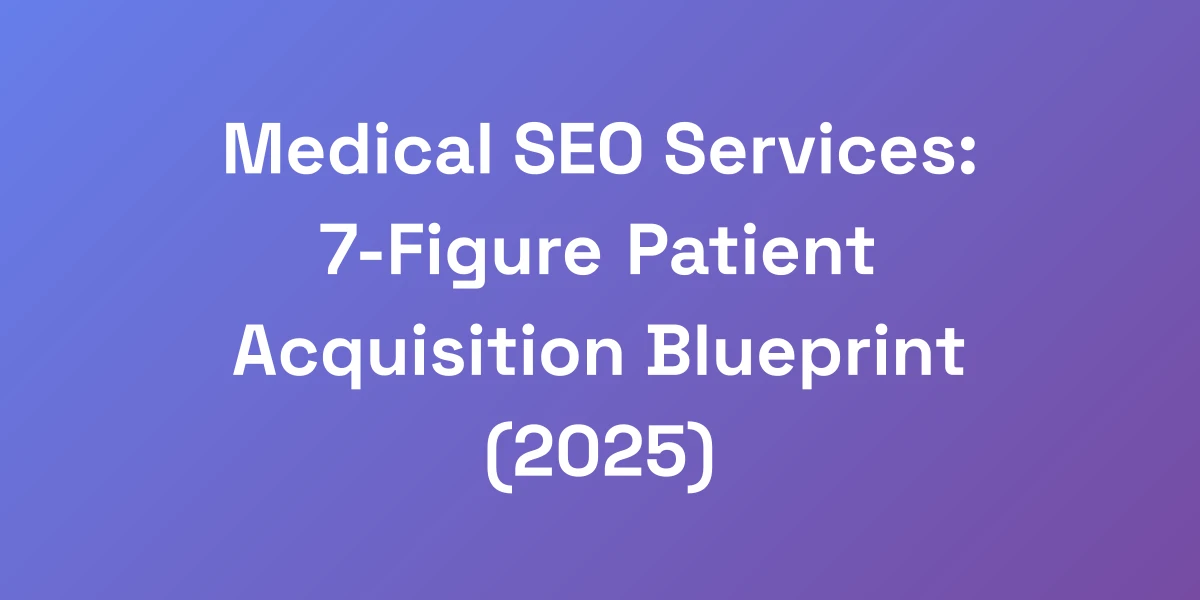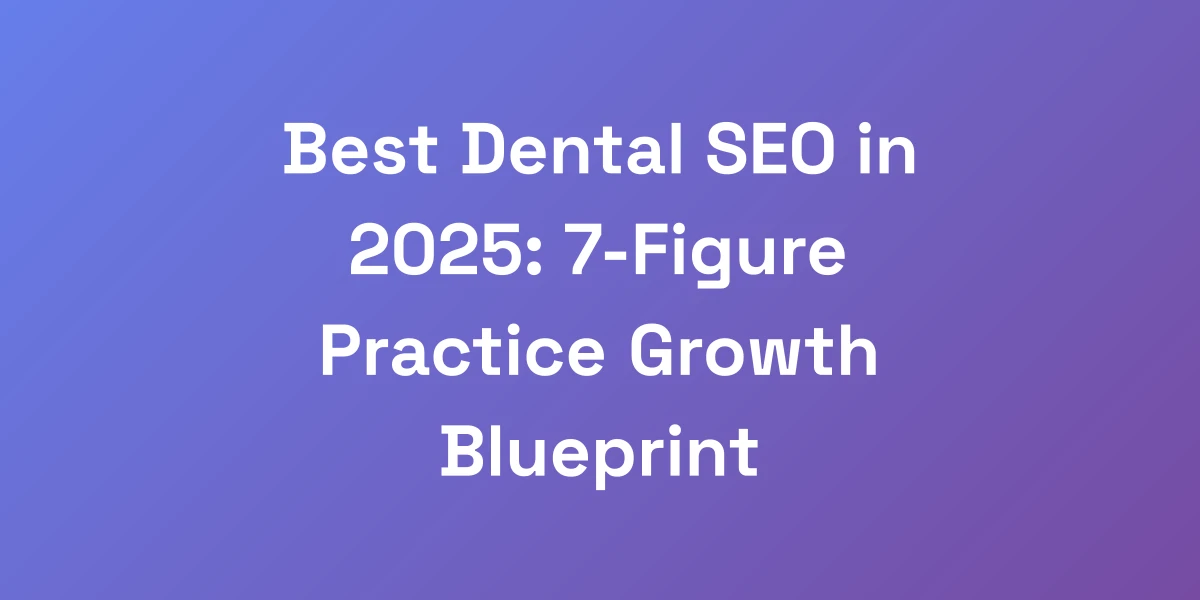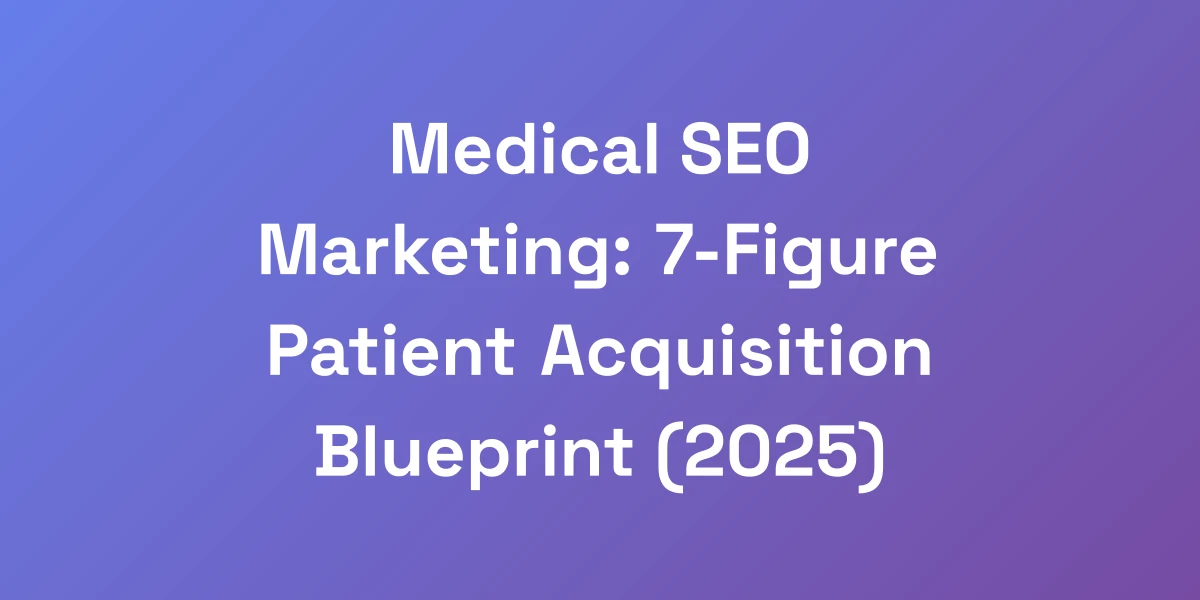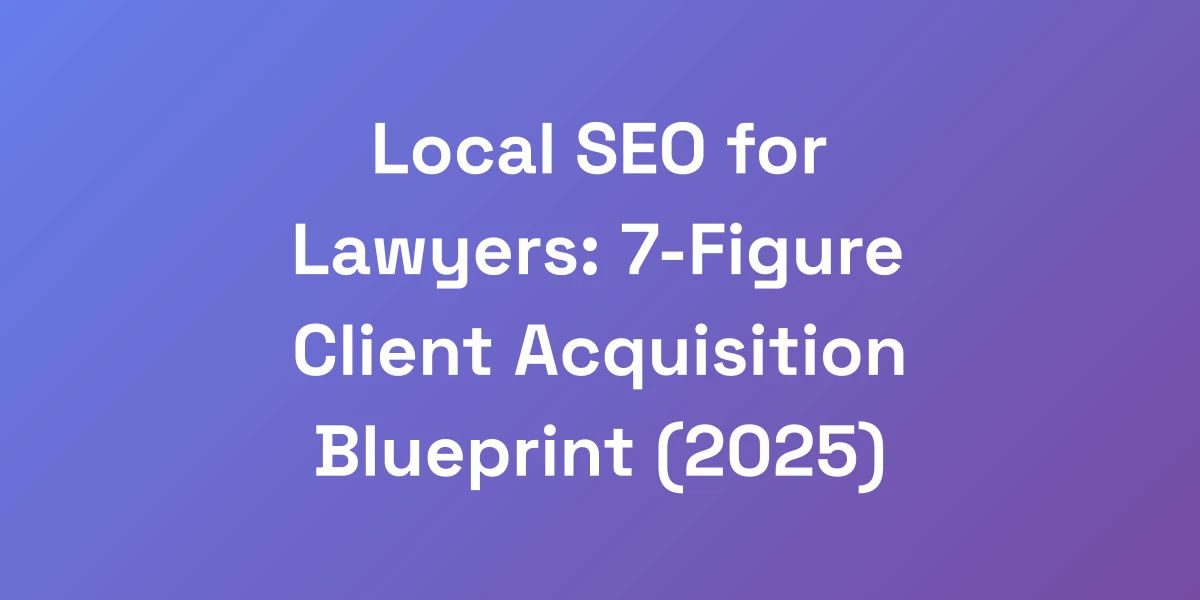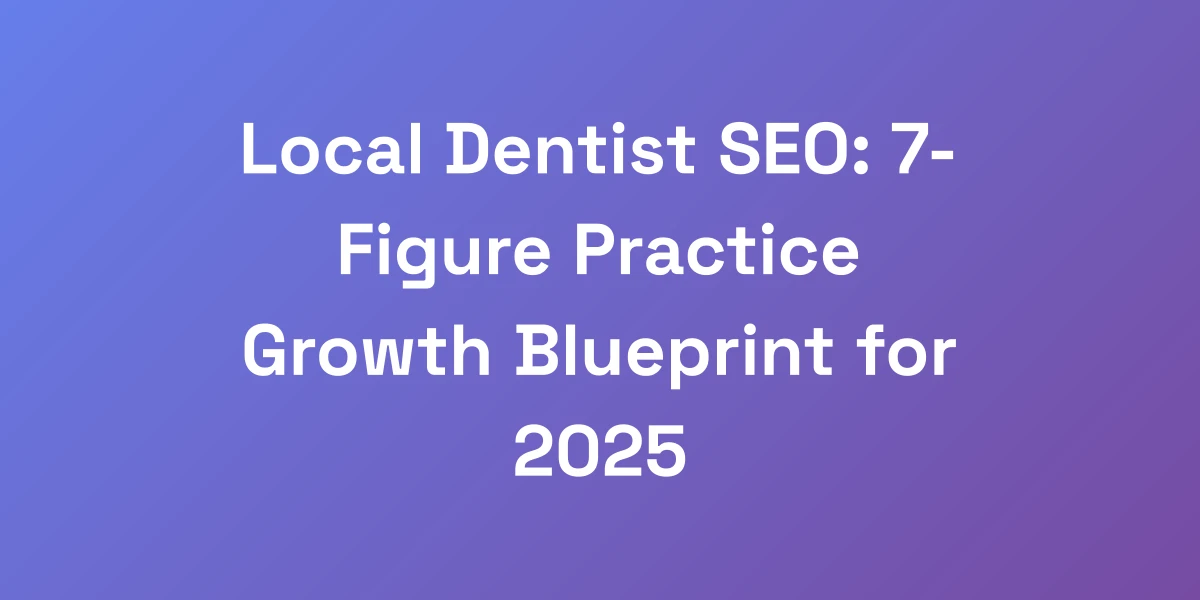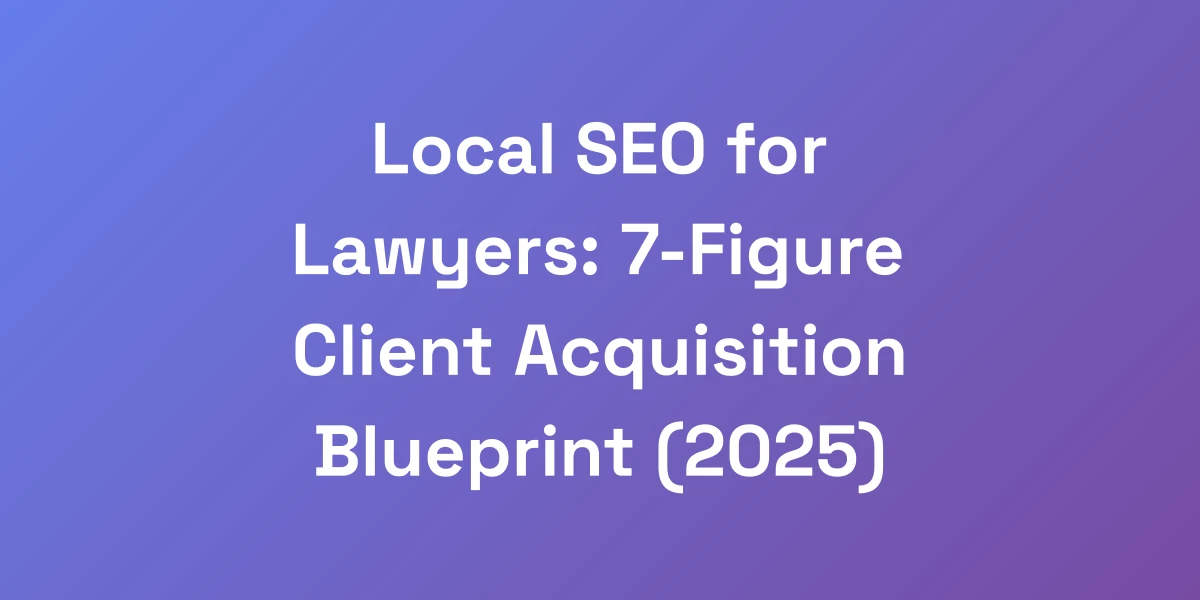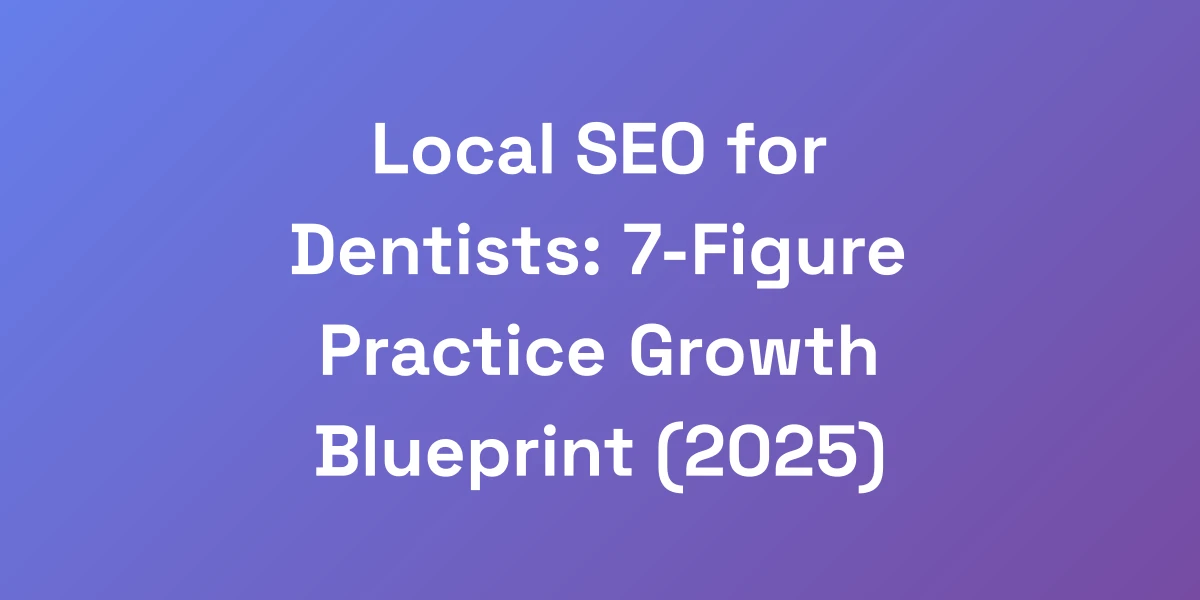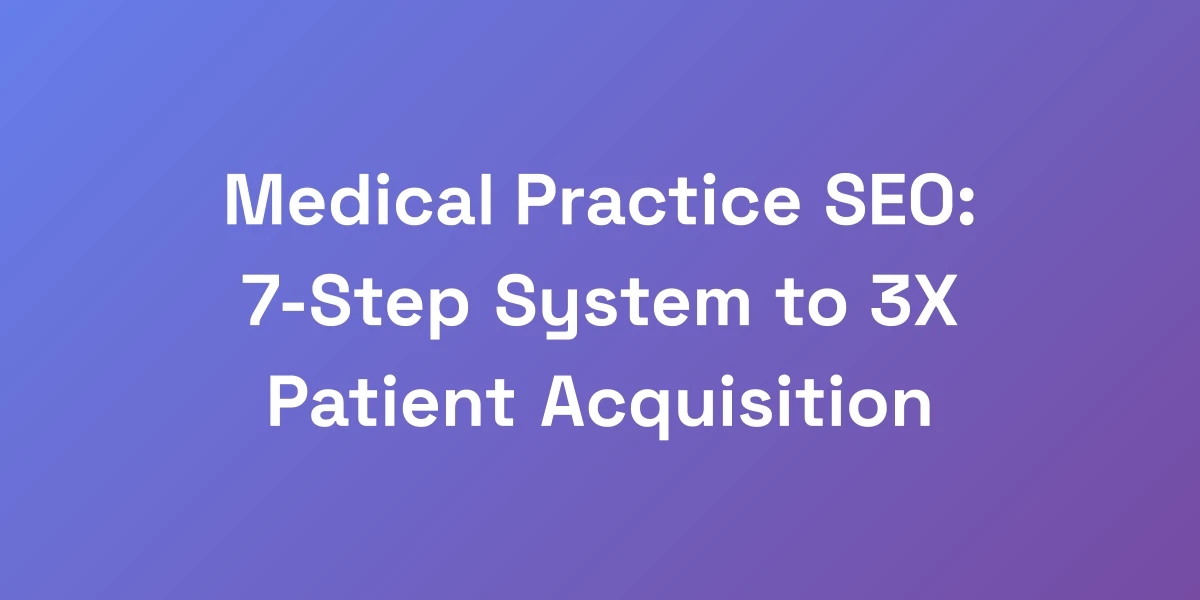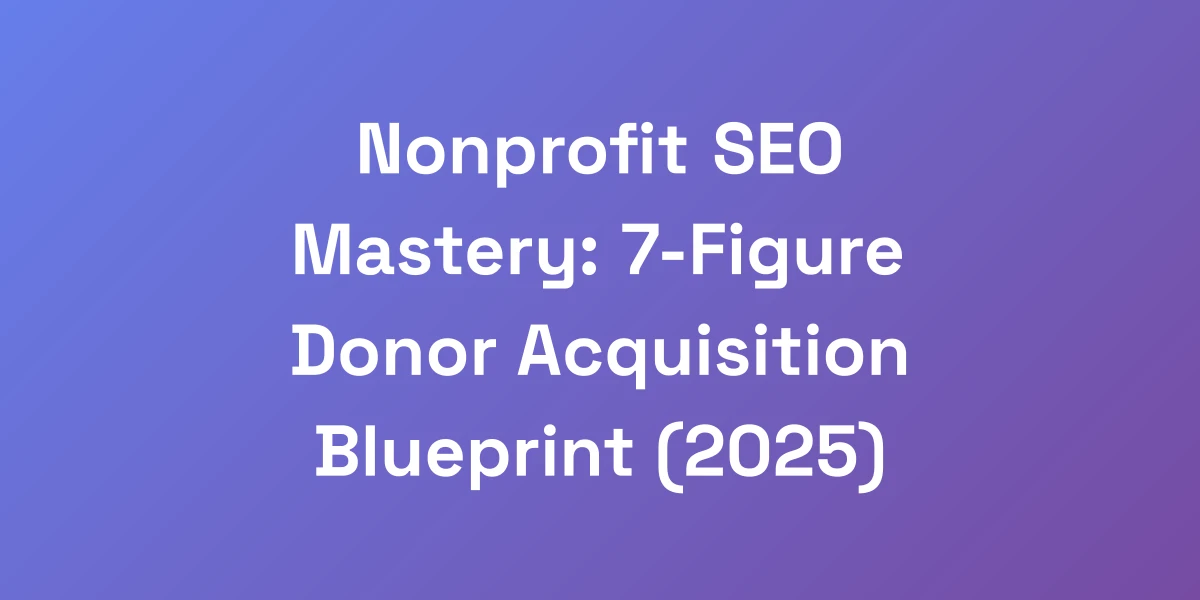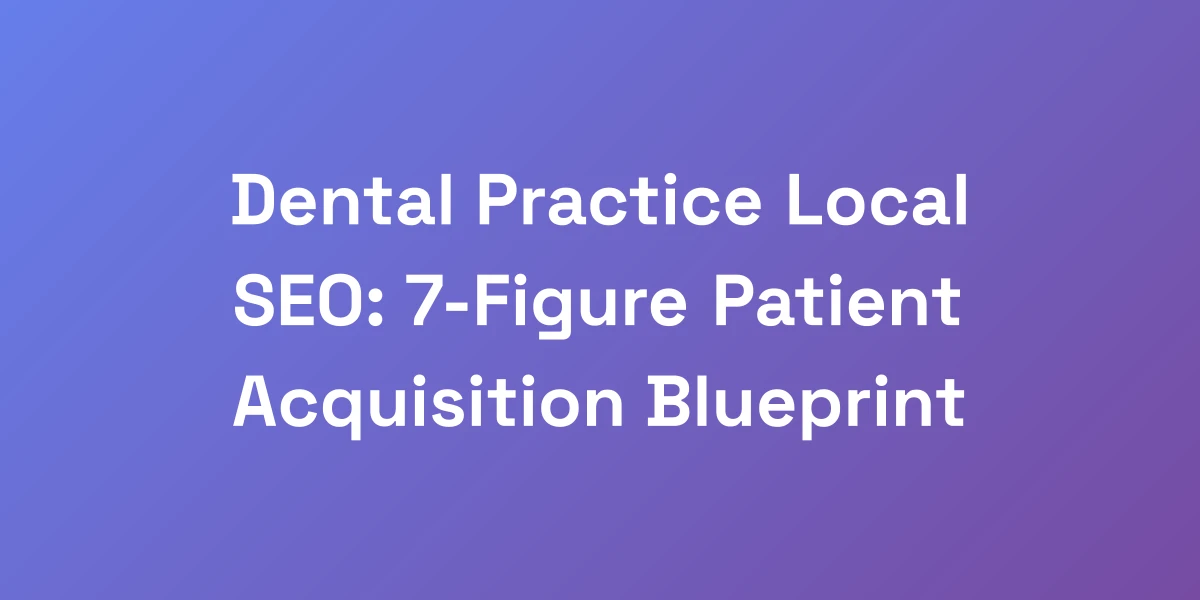
Dental Practice Local SEO: 7-Figure Patient Acquisition Blueprint
Feb 28, 2025 | By [email protected]
Why Most Dental Practices Fail at Local SEO (And How to Win)
Let us be brutally honest: 90% of dental practices are bleeding money by doing local SEO wrong. They’re stuck playing checkers while their competitors are playing chess.
Here’s the truth – dominating local search isn’t about fancy websites or throwing money at ads. It’s about understanding the fundamental principles of patient acquisition and leveraging them through strategic local SEO.
We’ve helped dental practices go from struggling to get 10 new patients a month to consistently bringing in 50+ high-value patients through organic search alone.
The difference? They stopped following outdated playbooks and started focusing on what actually moves the needle.
The Real Cost of Poor Local SEO Performance
Poor local SEO isn’t just a missed opportunity; it’s a direct hit to your bottom line.
Consider this: the average dental practice can lose hundreds of potential patients each month due to low visibility in local search results.
When your practice doesn’t appear in the top search results, you’re essentially handing over patients to your competitors.
And let’s not forget the hidden costs—the time and resources wasted on ineffective marketing strategies that yield minimal returns.
Moreover, with a local SEO conversion rate of nearly 50%, recent research supports this figure, meaning you’re not capitalizing on half of your potential patient base.
It’s not just about attracting more patients; it’s about attracting the right patients who are actively seeking your services.
Common Mistakes Killing Your Practice’s Visibility
Many dental practices stumble because they make fundamental SEO mistakes.
One major pitfall is neglecting their Google Business Profile. Setting it up once and forgetting about it is a recipe for disaster.
Another common error is insufficient keyword optimization. Without targeting the right terms, your practice remains invisible to potential patients.
Inconsistent NAP (Name, Address, Phone number) information across online directories can confuse search engines and harm your rankings.
Additionally, ignoring patient reviews is a critical mistake. With 98% of people reading local reviews, your reputation online directly impacts your practice’s credibility.
Lastly, many practices fail to create patient-centric content that addresses the actual needs and concerns of their audience.
The New Rules of Dental Local SEO for 2025
Local SEO isn’t static; it’s an ever-evolving field. Staying ahead means adapting to new rules and strategies.
First, focus on enhancing your user experience. Google’s algorithms prioritize websites that offer a seamless and intuitive experience on both desktop and mobile devices.
Second, leverage structured data and schema markup to help search engines understand your content better, improving your chances of appearing in rich snippets.
Third, prioritize voice search optimization. With the rise of smart speakers and voice assistants, optimizing for conversational queries is crucial.
Fourth, maintain a consistent and active Google Business Profile, continually updating it with fresh content, photos, and responding to reviews promptly.
Lastly, integrate local content marketing strategies that target specific community events, news, and local keywords to enhance relevance.
Case Study: How One Practice 10x’d Their Patient Flow
Let’s talk about REALTOP, a family dental practice in a highly competitive market.
They implemented a strategic SEO campaign that focused on expanding their active keywords from 50 to 310, significantly improving their visibility.
Organic traffic surged, leading to a 10x increase in search impressions and patient inquiries.
The secret? A comprehensive approach that included optimizing their Google Business Profile, creating patient-centric content, and consistently managing online reviews.
This practice saw their new patient numbers rise from 10 to over 100 per month, all through organic search alone.
It’s a testament to what can be achieved when you apply the right local SEO strategies with precision and consistency.
Understanding Google’s Local Search Algorithm
To master local SEO, you need to understand how Google’s local search algorithm works.
Google uses a combination of proximity, relevance, and prominence to determine local rankings.
Proximity refers to how close your practice is to the searcher’s location.
Relevance involves how well your practice matches the search intent based on your website and Google Business Profile information.
Prominence is determined by how well-known your practice is, based on online reviews, backlinks, and overall online presence.
By optimizing for these factors, you align your practice with what Google prioritizes, enhancing your chances of ranking higher in local search results.
Stay informed about updates in Google’s algorithms, as staying ahead of these changes can give you a competitive edge.
Mastering Google Business Profile for Dental Domination
Your Google Business Profile isn’t just another online listing—it’s your most powerful patient acquisition asset. Period.
When we work with dental practices, the first thing we optimize is their GBP, because it’s the fastest way to 2-3x your patient inquiries.
The secret? Creating what we call a “Trust Triangle“—combining strategic category selection, photo optimization, and review velocity to trigger Google’s trust signals.
Most dentists set up their profile once and forget it. But here’s what they don’t realize: Google’s local algorithm is constantly evolving, and your GBP needs to evolve with it.
Strategic Category Selection for Maximum Visibility
Choosing the right categories for your GBP is crucial. It affects how Google understands and ranks your practice.
Start by selecting the most specific categories relevant to your services, like “Pediatric Dentist” or “Orthodontist,” instead of generic terms like “Dental Care.”
This precision ensures that your practice appears in relevant searches, attracting patients specifically looking for your expertise.
Regularly review and update your categories to reflect any new services or specialties you offer.
Additionally, exploring secondary categories can open up new avenues for patient acquisition without diluting your primary focus.
Photo Optimization That Converts Browsers into Patients
Photos are a visual representation of your practice and play a significant role in attracting patients.
High-quality images of your office, staff, and services build trust and give potential patients a glimpse of what to expect.
Ensure your photos are professional, well-lit, and showcase your practice’s unique aspects.
Regularly update your photo gallery to keep your GBP fresh and engaging.
Include photos of your team, treatment rooms, and any recent renovations or new equipment to highlight your commitment to providing excellent care.
Review Velocity: The Hidden Rankings Multiplier
Reviews are more than just feedback; they’re a powerful ranking factor.
Maintaining a steady flow of new reviews signals to Google that your practice is active and trustworthy.
Encourage satisfied patients to leave reviews by integrating review requests into your post-visit follow-up processes.
Aim for consistency—having regular reviews rather than clusters at one time enhances your review velocity.
Responding to reviews, both positive and negative, shows that you value patient feedback and are committed to improving.
Advanced GBP Features Most Dentists Don’t Use
There are several advanced features in GBP that many dentists overlook.
Utilize the Q&A section to address common patient questions directly on your profile.
Leverage posts to share updates, promotions, and informative content that engages potential patients.
Enable booking through your GBP to streamline the appointment scheduling process.
Use the messaging feature to allow direct communication with potential patients, enhancing accessibility and response rates.
Implement attributes such as payment options, languages spoken, and special services to provide comprehensive information.
Monthly Optimization Checklist for Your GBP
Consistency is key when it comes to optimizing your Google Business Profile.
Each month, perform the following tasks to ensure your GBP remains optimized:
- Update business information and ensure NAP consistency across all directories.
- Add new photos showcasing any changes or additions to your practice.
- Respond to all new reviews promptly, addressing feedback professionally.
- Post at least two updates or offers to keep your profile active.
- Check and update service offerings to reflect any new treatments or specialties.
By adhering to this checklist, you maintain a dynamic and engaging GBP that continually attracts new patients.
The Patient-Centric Content Framework
Stop creating content for search engines and start creating content that actually solves patient problems.
The biggest mistake we see in dental practices is pumping out generic blog posts that nobody wants to read.
Instead, build what we call “Patient Journey Content Clusters“—interconnected content pieces that address every step of the patient’s decision-making process.
This isn’t just about keywords; it’s about understanding the psychological triggers that make someone choose your practice over competitors.
Creating High-Converting Service Pages
Your service pages are often the first point of interaction with potential patients. They need to be compelling and informative.
Start with clear, concise descriptions of each service you offer, highlighting the benefits and what sets your practice apart.
Include strong calls to action that guide visitors towards scheduling an appointment or contacting your office.
Incorporate patient testimonials and case studies to build credibility and trust.
Ensure each service page is optimized with relevant local keywords to enhance search visibility.
Example: For “Teeth Whitening,” include before-and-after photos, detailed process explanations, and FAQs to address common patient concerns.
Local Content That Actually Ranks
Local content is pivotal for connecting with your community and enhancing local SEO.
Create content that addresses local events, news, and topics relevant to your patient base.
For instance, write about the importance of dental health during local festivals or provide tips for maintaining oral hygiene in specific climates.
Incorporate local keywords naturally within your content to align with regional search queries.
Engage with local influencers or partner with nearby businesses to create collaborative content that broadens your reach.
This approach not only improves your SEO but also positions your practice as an integral part of the community.
Patient Journey Content Mapping
Understanding the patient journey is crucial for creating targeted content that guides potential patients from discovery to appointment.
Map out the typical stages a patient goes through:
- Awareness: Patients recognize they need dental services.
- Consideration: They research options and evaluate different practices.
- Decision: They decide to schedule an appointment with a chosen practice.
For each stage, create content that addresses the specific needs and questions of patients.
Example:
- Awareness: Blog posts on signs you need to see a dentist.
- Consideration: Articles comparing different dental treatments.
- Decision: Testimonials and detailed service pages to reassure and convince potential patients.
This targeted approach ensures your content meets patients where they are in their journey, increasing the likelihood of conversion.
Voice Search Optimization for Dental Queries
With the surge in voice-activated searches, optimizing for voice search queries is no longer optional.
Voice searches tend to be more conversational and question-based.
Focus on long-tail keywords and natural language phrases that people use when speaking.
Example: Instead of targeting “dentist near me,” optimize for “Who is the best dentist near me?”
Incorporate FAQs and Q&A sections on your website to mirror voice search queries.
Ensure your content is easily readable and structured in a way that answers questions directly and concisely.
By catering to voice search behavior, you capture a growing segment of search traffic that prefers hands-free, quick answers. Learn more about the impact of voice search.
Content Distribution Strategy for Maximum Impact
Creating great content is only half the battle; distributing it effectively is equally important.
Utilize multiple channels to amplify your content reach:
- Social Media: Share your blog posts, service pages, and updates on platforms like Facebook, Instagram, and LinkedIn.
- Email Marketing: Include your latest content in newsletters to keep your subscribers engaged and informed.
- Local Forums and Groups: Participate in local online communities and share relevant content to establish your expertise.
- Collaborations: Partner with local businesses or influencers to co-create and share content.
- SEO: Ensure your content is optimized for search engines to attract organic traffic continuously.
By diversifying your content distribution, you increase visibility, drive more traffic, and ultimately, attract more patients to your practice.
Technical SEO Fundamentals for Dental Websites
Your website’s technical foundation can make or break your local SEO success. But here’s the thing—you don’t need to be a tech genius to get this right.
What you need is a systematic approach to technical optimization that focuses on the elements Google actually cares about.
We’ve seen practices waste thousands on unnecessary technical fixes while ignoring the core elements that actually impact rankings.
Let’s cut through the noise and focus on what matters.
Mobile-First Optimization Checklist
With 57% of local searches coming from mobile devices, ensuring your website is mobile-friendly is non-negotiable.
- Responsive design that adapts to different screen sizes.
- Fast loading times to reduce bounce rates.
- Easy navigation with clear calls to action.
- Optimized images and media for quicker load times.
- Touch-friendly buttons and links for seamless interaction.
Regularly test your website on various devices to ensure a consistent and smooth user experience.
Schema Markup for Dental Practices
Schema markup helps search engines understand the content of your website, enhancing your visibility in search results.
For dental practices, implementing LocalBusiness schema can provide detailed information such as business hours, services, and contact details.
Additionally, using Review and FAQ schemas can help your site appear in rich snippets, attracting more clicks.
Proper schema implementation can significantly boost your local SEO performance by making your information more accessible and appealing to search engines.
Site Speed Optimization Protocol
Website speed is a critical factor in both user experience and SEO rankings.
A slow-loading website drives potential patients away and negatively impacts your search rankings.
Here’s how to optimize your site speed:
- Minimize HTTP requests by reducing the number of elements on each page.
- Use browser caching to store frequently accessed resources.
- Optimize images by compressing them without losing quality.
- Implement a Content Delivery Network (CDN) to speed up content delivery.
- Minimize and defer JavaScript and CSS files to reduce render-blocking.
Regularly monitor your site’s speed using tools like Google PageSpeed Insights and make necessary adjustments to maintain optimal performance.
Local Citation Architecture
Local citations—mentions of your practice online, even without a link—are essential for local SEO.
Maintaining consistent NAP (Name, Address, Phone number) information across all directories is crucial.
Here’s how to build a robust local citation architecture:
- List your practice on major directories like Google My Business, Yelp, and Healthgrades.
- Ensure consistency in your NAP details across all platforms.
- Use local keywords in your practice descriptions to enhance relevance.
- Avoid duplicate listings, which can confuse search engines and harm your rankings.
- Regularly audit your citations to ensure accuracy and completeness.
A strong citation profile boosts your local SEO by signaling to Google that your practice is a legitimate and established business in your area.
Technical Audit Framework
Regular technical audits are essential to identify and rectify issues that could hinder your SEO performance. To enhance this process, consider automate SEO reporting.
Here’s a comprehensive technical audit framework for dental websites:
- Site Crawl: Use tools like Screaming Frog to crawl your site and identify broken links, duplicate content, and missing metadata, along with SEO automation tools.
- Mobile Usability: Ensure your site performs well on all mobile devices, checking for responsive design and touch-friendly elements.
- Page Speed: Analyze and optimize your site’s loading times to improve user experience and search rankings.
- Schema Markup: Verify that all relevant schema markup is correctly implemented and functioning.
- Security: Ensure your site uses HTTPS to protect patient data and enhance trust.
- URL Structure: Maintain a clean and logical URL structure, using keywords where appropriate.
- Internal Linking: Optimize internal links to improve navigation and distribute page authority effectively using automated SEO reporting.
Conducting regular technical audits helps maintain a healthy website that supports your local SEO efforts, ensuring sustained visibility and patient acquisition.
The Review Generation System That Scales
Reviews are the lifeblood of local SEO for dental practices. But begging patients for reviews isn’t a strategy—it’s a recipe for burnout.
Instead, we need to build what we call a “Review Generation Engine“—a systematic approach to consistently generate high-quality reviews that boost both rankings and conversions.
The key is to make review generation a natural part of your patient experience, not an afterthought.
Automated Review Collection Systems
Automation can streamline the process of collecting reviews, saving time and ensuring consistency.
Implement an automated system that sends review requests via email or SMS shortly after a patient’s appointment.
Ensure the process is simple—provide direct links to your GBP or review platforms to make it easy for patients to leave feedback.
Personalize the requests to make patients feel valued and appreciated, increasing the likelihood of positive reviews.
By automating review collection, you maintain a steady influx of new feedback without overwhelming your team.
Response Templates That Build Trust
Responding to reviews promptly and professionally is crucial for building trust and demonstrating your commitment to patient satisfaction.
Develop a set of response templates that can be tailored to individual reviews. Ensure they are personalized and address the specific points raised by the patient.
For positive reviews, express gratitude and highlight your dedication to excellent care.
For negative reviews, acknowledge the issue, apologize, and offer a solution or a way to make things right.
Consistent and thoughtful responses show that you value all feedback, enhancing your practice’s reputation and encouraging more patients to leave reviews.
Managing Negative Reviews Effectively
Negative reviews can be challenging, but they also present an opportunity to demonstrate your commitment to patient satisfaction.
When addressing negative feedback, remain calm and professional. Acknowledge the patient’s experience and apologize sincerely.
Offer to resolve the issue offline, providing contact information for further discussion.
By handling negative reviews gracefully, you can turn dissatisfied patients into loyal ones and show potential patients that you are dedicated to resolving issues.
Remember, responding to negative reviews transparently can build trust and improve your overall online reputation.
Review Velocity Optimization
Review velocity—the rate at which you receive new reviews—plays a significant role in your local SEO rankings.
A consistent flow of new reviews signals to Google that your practice is active and engaged with patients.
To optimize review velocity:
- Encourage reviews regularly after each appointment.
- Vary the timing of review requests to avoid clusters.
- Use multiple channels, such as email, SMS, and in-office prompts, to reach patients.
- Monitor review frequency and adjust your strategies to maintain a steady stream.
By optimizing review velocity, you enhance your practice’s visibility and attractiveness to potential patients.
Multi-Platform Review Strategy
While Google Business Profile is a primary platform, diversifying your reviews across multiple platforms can amplify their impact.
Encourage patients to leave reviews on platforms like Yelp, Healthgrades, and Facebook.
Each platform has its own audience and search visibility benefits, contributing to a more comprehensive online presence.
Ensure consistency in your NAP information across all review platforms to strengthen your local SEO signals.
By implementing a multi-platform review strategy, you broaden your practice’s reach and build a more robust online reputation.
This approach not only enhances your SEO but also provides a richer array of testimonials for prospective patients to consider.
Conclusion
In the competitive world of dental practices, mastering local SEO is not just an option—it’s a necessity for sustainable growth and patient acquisition.
We’ve explored a comprehensive blueprint that addresses the core elements of local SEO, from optimizing your Google Business Profile to creating patient-centric content and building a scalable review generation system.
The key takeaways are clear: focus on understanding and implementing the fundamental principles of patient acquisition, maintain a systematic approach to technical optimization, and ensure consistent, high-quality engagement with your online presence.
Now, it’s time to take action. Implement these strategies, monitor your progress, and continuously refine your approach to stay ahead of the competition.
Ready to transform your dental practice and achieve 7-figure patient acquisition? Start today by optimizing your local SEO and watch your practice thrive.
What’s your biggest challenge with local SEO? Share your thoughts and let’s conquer it together!
